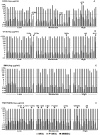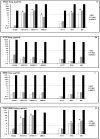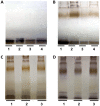Growing Burkholderia pseudomallei in biofilm stimulating conditions significantly induces antimicrobial resistance
- PMID: 20169199
- PMCID: PMC2820546
- DOI: 10.1371/journal.pone.0009196
Growing Burkholderia pseudomallei in biofilm stimulating conditions significantly induces antimicrobial resistance
Abstract
Background: Burkholderia pseudomallei, a gram-negative bacterium that causes melioidosis, was reported to produce biofilm. As the disease causes high relapse rate when compared to other bacterial infections, it therefore might be due to the reactivation of the biofilm forming bacteria which also provided resistance to antimicrobial agents. However, the mechanism on how biofilm can provide tolerance to antimicrobials is still unclear.
Methodology/principal findings: The change in resistance of B. pseudomallei to doxycycline, ceftazidime, imipenem, and trimethoprim/sulfamethoxazole during biofilm formation were measured as minimum biofilm elimination concentration (MBEC) in 50 soil and clinical isolates and also in capsule, flagellin, LPS and biofilm mutants. Almost all planktonic isolates were susceptible to all agents studied. In contrast, when they were grown in the condition that induced biofilm formation, they were markedly resistant to all antimicrobial agents even though the amount of biofilm production was not the same. The capsule and O-side chains of LPS mutants had no effect on biofilm formation whereas the flagellin-defective mutant markedly reduced in biofilm production. No alteration of LPS profiles was observed when susceptible form was changed to resistance. The higher amount of N-acyl homoserine lactones (AHLs) was detected in the high biofilm-producing isolates. Interestingly, the biofilm mutant which produced a very low amount of biofilm and was sensitive to antimicrobial agents significantly resisted those agents when grown in biofilm inducing condition.
Conclusions/significance: The possible drug resistance mechanism of biofilm mutants and other isolates is not by having biofilm but rather from some factors that up-regulated when biofilm formation genes were stimulated. The understanding of genes related to this situation may lead us to prevent B. pseudomallei biofilms leading to the relapse of melioidosis.
Conflict of interest statement
Figures




References
-
- Chaowagul W, White NJ, Dance DA, Wattanagoon Y, Naigowit P, et al. Melioidosis: a major cause of community-acquired septicemia in northeastern Thailand. J Infect Dis. 1989;159:890–899. - PubMed
-
- White NJ. Melioidosis. Lancet. 2003;361:1715–1722. - PubMed
-
- Dance DA, Wuthiekanun V, Chaowagul W, White NJ. The antimicrobial susceptibility of Pseudomonas pseudomallei. Emergence of resistance in vitro and during treatment. J Antimicrob Chemother. 1989;24:295–309. - PubMed
-
- Jenney AW, Lum G, Fisher DA, Currie BJ. Antibiotic susceptibility of Burkholderia pseudomallei from tropical northern Australia and implications for therapy of melioidosis. Int J Antimicrob Agents. 2001;17:109–113. - PubMed
-
- Vorachit M, Lam K, Jayanetra P, Costerton JW. Electron microscopy study of the mode of growth of Pseudomonas pseudomallei in vitro and in vivo. J Trop Med Hyg. 1995;98:379–391. - PubMed
Publication types
MeSH terms
Substances
LinkOut - more resources
Full Text Sources
Other Literature Sources
Research Materials

